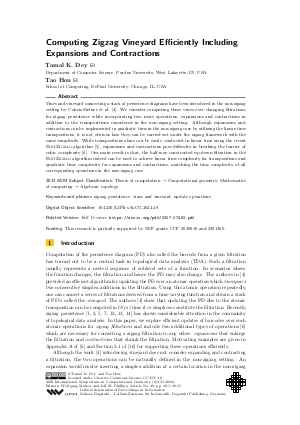Computing Zigzag Vineyard Efficiently Including Expansions and Contractions
Authors Tamal K. Dey, Tao Hou
-
Part of:
Volume:
40th International Symposium on Computational Geometry (SoCG 2024)
Part of: Series: Leibniz International Proceedings in Informatics (LIPIcs)
Part of: Conference: Symposium on Computational Geometry (SoCG) - License:
 Creative Commons Attribution 4.0 International license
Creative Commons Attribution 4.0 International license
- Publication Date: 2024-06-06
File

PDF
LIPIcs.SoCG.2024.49.pdf
- Filesize: 0.82 MB
- 15 pages
Document Identifiers
Related Versions
- Full Version https://arxiv.org/pdf/2307.07462.pdf
Subject Classification
ACM Subject Classification
- Theory of computation → Computational geometry
- Mathematics of computing → Algebraic topology
Keywords
- zigzag persistence
- vines and vineyard
- update operations
Metrics
- Access Statistics
-
Total Accesses (updated on a weekly basis)
0PDF Downloads0Metadata Views
Abstract
Vines and vineyard connecting a stack of persistence diagrams have been introduced in the non-zigzag setting by Cohen-Steiner et al. [Cohen-Steiner et al., 2006]. We consider computing these vines over changing filtrations for zigzag persistence while incorporating two more operations: expansions and contractions in addition to the transpositions considered in the non-zigzag setting. Although expansions and contractions can be implemented in quadratic time in the non-zigzag case by utilizing the linear-time transpositions, it is not obvious how they can be carried out under the zigzag framework with the same complexity. While transpositions alone can be easily conducted in linear time using the recent FastZigzag algorithm [Tamal K. Dey and Tao Hou, 2022], expansions and contractions pose difficulty in breaking the barrier of cubic complexity [Dey and Hou, 2022]. Our main result is that, the half-way constructed up-down filtration in the FastZigzag algorithm indeed can be used to achieve linear time complexity for transpositions and quadratic time complexity for expansions and contractions, matching the time complexity of all corresponding operations in the non-zigzag case.
Cite As Get BibTex
Tamal K. Dey and Tao Hou. Computing Zigzag Vineyard Efficiently Including Expansions and Contractions. In 40th International Symposium on Computational Geometry (SoCG 2024). Leibniz International Proceedings in Informatics (LIPIcs), Volume 293, pp. 49:1-49:15, Schloss Dagstuhl – Leibniz-Zentrum für Informatik (2024)
https://doi.org/10.4230/LIPIcs.SoCG.2024.49
BibTex
@InProceedings{dey_et_al:LIPIcs.SoCG.2024.49,
author = {Dey, Tamal K. and Hou, Tao},
title = {{Computing Zigzag Vineyard Efficiently Including Expansions and Contractions}},
booktitle = {40th International Symposium on Computational Geometry (SoCG 2024)},
pages = {49:1--49:15},
series = {Leibniz International Proceedings in Informatics (LIPIcs)},
ISBN = {978-3-95977-316-4},
ISSN = {1868-8969},
year = {2024},
volume = {293},
editor = {Mulzer, Wolfgang and Phillips, Jeff M.},
publisher = {Schloss Dagstuhl -- Leibniz-Zentrum f{\"u}r Informatik},
address = {Dagstuhl, Germany},
URL = {https://drops.dagstuhl.de/entities/document/10.4230/LIPIcs.SoCG.2024.49},
URN = {urn:nbn:de:0030-drops-199942},
doi = {10.4230/LIPIcs.SoCG.2024.49},
annote = {Keywords: zigzag persistence, vines and vineyard, update operations}
}
Author Details
Funding
This research is partially supported by NSF grants CCF 2049010 and 2301360.
References
-
Gunnar Carlsson and Vin de Silva. Zigzag persistence. Foundations of Computational Mathematics, 10(4):367-405, 2010.

-
Gunnar Carlsson, Vin de Silva, and Dmitriy Morozov. Zigzag persistent homology and real-valued functions. In Proceedings of the Twenty-Fifth Annual Symposium on Computational Geometry, pages 247-256, 2009.

-
David Cohen-Steiner, Herbert Edelsbrunner, and John Harer. Extending persistence using Poincaré and Lefschetz duality. Foundations of Computational Mathematics, 9(1):79-103, 2009.

-
David Cohen-Steiner, Herbert Edelsbrunner, and Dmitriy Morozov. Vines and vineyards by updating persistence in linear time. In Proceedings of the Twenty-Second Annual Symposium on Computational Geometry, pages 119-126, 2006.

-
Tamal K. Dey and Tao Hou. Fast computation of zigzag persistence. In 30th Annual European Symposium on Algorithms, ESA 2022, September 5-9, 2022, Berlin/Potsdam, Germany, volume 244 of LIPIcs, pages 43:1-43:15. Schloss Dagstuhl - Leibniz-Zentrum für Informatik, 2022.

- Tamal K. Dey and Tao Hou. Updating barcodes and representatives for zigzag persistence. arXiv preprint, 2022. URL: https://arxiv.org/abs/2112.02352.
-
Tamal K. Dey, Tao Hou, and Salman Parsa. Revisiting graph persistence for updates and efficiency. In 18th Algorithms and Data Structures Symposium (WADS 2023), to appear, 2023.

-
Herbert Edelsbrunner, David Letscher, and Afra Zomorodian. Topological persistence and simplification. In Proceedings 41st Annual Symposium on Foundations of Computer Science, pages 454-463. IEEE, 2000.

- Samuel Eilenberg and J. A. Zilber. Semi-simplicial complexes and singular homology. Annals of Mathematics, 51(3):499-513, 1950. URL: http://www.jstor.org/stable/1969364.
-
Peter Gabriel. Unzerlegbare Darstellungen I. Manuscripta Mathematica, 6(1):71-103, 1972.

-
Allen Hatcher. Algebraic Topology. Cambridge University Press, 2002.

-
Michael Kerber and Hannah Schreiber. Barcodes of towers and a streaming algorithm for persistent homology. Discrete & computational geometry, 61:852-879, 2019.

-
Clément Maria and Steve Y. Oudot. Zigzag persistence via reflections and transpositions. In Proceedings of the Twenty-Sixth Annual ACM-SIAM Symposium on Discrete Algorithms, pages 181-199. SIAM, 2014.

- Clément Maria and Steve Y. Oudot. Computing zigzag persistent cohomology. arXiv preprint, 2016. URL: https://arxiv.org/abs/1608.06039.
-
Steve Y. Oudot and Donald R. Sheehy. Zigzag zoology: Rips zigzags for homology inference. Foundations of Computational Mathematics, 15(5):1151-1186, 2015.

-
Sarah Tymochko, Elizabeth Munch, and Firas A. Khasawneh. Using zigzag persistent homology to detect Hopf bifurcations in dynamical systems. Algorithms, 13(11):278, 2020.

